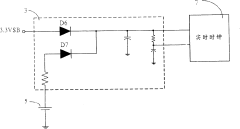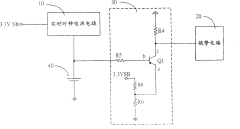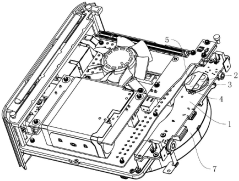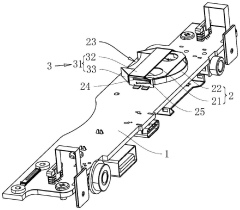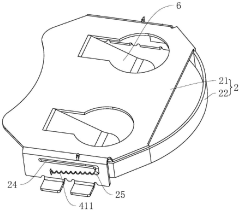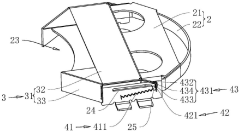How to Address CMOS Battery Failure in Computers?
JUL 22, 20258 MIN READ
Generate Your Research Report Instantly with AI Agent
Patsnap Eureka helps you evaluate technical feasibility & market potential.
CMOS Battery Evolution and Objectives
The evolution of CMOS (Complementary Metal-Oxide-Semiconductor) battery technology in computers has been a crucial aspect of maintaining system integrity and functionality. Initially introduced in the 1980s, CMOS batteries have played a vital role in preserving essential system settings and real-time clock information when the main power source is disconnected.
In the early days of personal computing, CMOS batteries were primarily used to maintain basic system configuration data and keep the real-time clock running. As computer systems became more complex, the importance of CMOS batteries grew, extending to storing BIOS settings, hardware configurations, and even security parameters.
The technology behind CMOS batteries has progressed significantly over the years. Early implementations used nickel-cadmium (NiCd) batteries, which were later replaced by lithium-ion (Li-ion) batteries due to their improved energy density and longer lifespan. Modern CMOS batteries are typically lithium coin cells, offering a balance between size, capacity, and longevity.
One of the primary objectives in CMOS battery evolution has been to extend battery life. Early CMOS batteries often required replacement every 2-3 years, causing inconvenience and potential data loss. Current lithium coin cells can last up to 10 years or more, significantly reducing maintenance requirements and improving system reliability.
Another key goal has been to minimize the impact of battery failure on system operation. Manufacturers have implemented various strategies, such as non-volatile memory for critical settings and improved power management techniques, to reduce reliance on the CMOS battery and mitigate the effects of battery depletion.
The miniaturization of computer components has also driven CMOS battery evolution. As laptops, tablets, and other portable devices have become increasingly compact, the need for smaller, more efficient CMOS power solutions has grown. This has led to the development of integrated CMOS battery solutions and alternative power storage technologies.
Looking forward, the objectives for CMOS battery technology include further extending battery life, developing more environmentally friendly power sources, and exploring alternative methods for maintaining system settings and real-time information. Emerging technologies such as supercapacitors and solid-state batteries show promise in addressing these goals, potentially revolutionizing how computers maintain critical information during power-off states.
In the early days of personal computing, CMOS batteries were primarily used to maintain basic system configuration data and keep the real-time clock running. As computer systems became more complex, the importance of CMOS batteries grew, extending to storing BIOS settings, hardware configurations, and even security parameters.
The technology behind CMOS batteries has progressed significantly over the years. Early implementations used nickel-cadmium (NiCd) batteries, which were later replaced by lithium-ion (Li-ion) batteries due to their improved energy density and longer lifespan. Modern CMOS batteries are typically lithium coin cells, offering a balance between size, capacity, and longevity.
One of the primary objectives in CMOS battery evolution has been to extend battery life. Early CMOS batteries often required replacement every 2-3 years, causing inconvenience and potential data loss. Current lithium coin cells can last up to 10 years or more, significantly reducing maintenance requirements and improving system reliability.
Another key goal has been to minimize the impact of battery failure on system operation. Manufacturers have implemented various strategies, such as non-volatile memory for critical settings and improved power management techniques, to reduce reliance on the CMOS battery and mitigate the effects of battery depletion.
The miniaturization of computer components has also driven CMOS battery evolution. As laptops, tablets, and other portable devices have become increasingly compact, the need for smaller, more efficient CMOS power solutions has grown. This has led to the development of integrated CMOS battery solutions and alternative power storage technologies.
Looking forward, the objectives for CMOS battery technology include further extending battery life, developing more environmentally friendly power sources, and exploring alternative methods for maintaining system settings and real-time information. Emerging technologies such as supercapacitors and solid-state batteries show promise in addressing these goals, potentially revolutionizing how computers maintain critical information during power-off states.
Market Analysis for CMOS Battery Solutions
The CMOS battery market for computers is experiencing steady growth due to the increasing demand for reliable power sources in electronic devices. As computers become more prevalent in both personal and professional settings, the need for CMOS batteries to maintain system settings and real-time clock functions has become crucial. The market is primarily driven by the rising number of computer users worldwide, the growing importance of data integrity, and the expanding IT infrastructure across various industries.
The global CMOS battery market is segmented based on type, application, and region. Types include CR2032, CR2025, and others, with CR2032 being the most commonly used in computer systems. Applications span desktop computers, laptops, servers, and other electronic devices that require constant power for memory retention.
Market trends indicate a shift towards more energy-efficient and longer-lasting CMOS batteries. Manufacturers are focusing on developing batteries with improved capacity and extended lifespan to meet the demands of modern computing systems. Additionally, there is a growing interest in environmentally friendly battery solutions, driving research into sustainable materials and recycling processes.
The market for CMOS battery solutions is highly competitive, with several key players dominating the industry. These companies are investing in research and development to enhance battery performance and reliability. The market is also witnessing the entry of new players, particularly in emerging economies, leading to increased competition and innovation.
Geographically, North America and Europe hold significant market shares due to the high adoption of advanced technologies and the presence of major computer manufacturers. However, the Asia-Pacific region is expected to show the highest growth rate in the coming years, driven by the rapid expansion of the IT sector and increasing computer penetration in countries like China and India.
The COVID-19 pandemic has had a mixed impact on the CMOS battery market. While it initially disrupted supply chains and manufacturing processes, the subsequent increase in remote work and digital transformation initiatives has boosted demand for computers and related components, including CMOS batteries.
Looking ahead, the market for CMOS battery solutions is projected to continue its growth trajectory. Factors such as the increasing complexity of computer systems, the rise of IoT devices, and the growing importance of data centers are expected to drive demand. Moreover, the development of smart cities and the ongoing digital transformation across industries will likely create new opportunities for CMOS battery manufacturers and suppliers.
The global CMOS battery market is segmented based on type, application, and region. Types include CR2032, CR2025, and others, with CR2032 being the most commonly used in computer systems. Applications span desktop computers, laptops, servers, and other electronic devices that require constant power for memory retention.
Market trends indicate a shift towards more energy-efficient and longer-lasting CMOS batteries. Manufacturers are focusing on developing batteries with improved capacity and extended lifespan to meet the demands of modern computing systems. Additionally, there is a growing interest in environmentally friendly battery solutions, driving research into sustainable materials and recycling processes.
The market for CMOS battery solutions is highly competitive, with several key players dominating the industry. These companies are investing in research and development to enhance battery performance and reliability. The market is also witnessing the entry of new players, particularly in emerging economies, leading to increased competition and innovation.
Geographically, North America and Europe hold significant market shares due to the high adoption of advanced technologies and the presence of major computer manufacturers. However, the Asia-Pacific region is expected to show the highest growth rate in the coming years, driven by the rapid expansion of the IT sector and increasing computer penetration in countries like China and India.
The COVID-19 pandemic has had a mixed impact on the CMOS battery market. While it initially disrupted supply chains and manufacturing processes, the subsequent increase in remote work and digital transformation initiatives has boosted demand for computers and related components, including CMOS batteries.
Looking ahead, the market for CMOS battery solutions is projected to continue its growth trajectory. Factors such as the increasing complexity of computer systems, the rise of IoT devices, and the growing importance of data centers are expected to drive demand. Moreover, the development of smart cities and the ongoing digital transformation across industries will likely create new opportunities for CMOS battery manufacturers and suppliers.
Current Challenges in CMOS Battery Technology
CMOS battery technology in computers faces several significant challenges that impact system reliability and user experience. One of the primary issues is the limited lifespan of CMOS batteries, typically ranging from 2 to 10 years. This variability in battery life creates uncertainty for users and system administrators, making it difficult to predict when replacement will be necessary.
The gradual degradation of CMOS batteries over time poses another challenge. As the battery weakens, it may lead to intermittent system issues before complete failure occurs. These issues can manifest as incorrect system time and date settings, loss of BIOS configurations, and boot failures, which can be difficult to diagnose and often mistaken for other hardware problems.
Environmental factors also play a crucial role in CMOS battery performance. Extreme temperatures, both hot and cold, can significantly reduce battery life and efficiency. This is particularly problematic for computers used in industrial settings or harsh environments where temperature control is challenging.
The physical design of CMOS batteries presents additional challenges. Many modern laptops and compact desktops use soldered-on CMOS batteries to save space, making replacement a complex and potentially costly process. This design choice often requires professional service, increasing downtime and maintenance costs for users and businesses.
Another significant challenge is the environmental impact of CMOS battery disposal. As these batteries contain lithium and other potentially harmful materials, proper disposal is crucial to prevent environmental contamination. However, the small size of CMOS batteries often leads to improper disposal, contributing to electronic waste issues.
The increasing complexity of computer systems also impacts CMOS battery technology. Modern computers with advanced power management features and always-on capabilities may drain CMOS batteries more quickly than older systems. This accelerated drain can lead to more frequent battery failures and the need for replacements.
Lastly, the lack of standardization in CMOS battery types and sizes across different computer models and manufacturers creates challenges for both users and service providers. This diversity complicates the replacement process and can lead to compatibility issues when attempting to source replacement batteries.
The gradual degradation of CMOS batteries over time poses another challenge. As the battery weakens, it may lead to intermittent system issues before complete failure occurs. These issues can manifest as incorrect system time and date settings, loss of BIOS configurations, and boot failures, which can be difficult to diagnose and often mistaken for other hardware problems.
Environmental factors also play a crucial role in CMOS battery performance. Extreme temperatures, both hot and cold, can significantly reduce battery life and efficiency. This is particularly problematic for computers used in industrial settings or harsh environments where temperature control is challenging.
The physical design of CMOS batteries presents additional challenges. Many modern laptops and compact desktops use soldered-on CMOS batteries to save space, making replacement a complex and potentially costly process. This design choice often requires professional service, increasing downtime and maintenance costs for users and businesses.
Another significant challenge is the environmental impact of CMOS battery disposal. As these batteries contain lithium and other potentially harmful materials, proper disposal is crucial to prevent environmental contamination. However, the small size of CMOS batteries often leads to improper disposal, contributing to electronic waste issues.
The increasing complexity of computer systems also impacts CMOS battery technology. Modern computers with advanced power management features and always-on capabilities may drain CMOS batteries more quickly than older systems. This accelerated drain can lead to more frequent battery failures and the need for replacements.
Lastly, the lack of standardization in CMOS battery types and sizes across different computer models and manufacturers creates challenges for both users and service providers. This diversity complicates the replacement process and can lead to compatibility issues when attempting to source replacement batteries.
Existing CMOS Battery Failure Solutions
01 Detection and monitoring of CMOS battery failure
Systems and methods for detecting and monitoring CMOS battery failure in electronic devices. This includes techniques for measuring battery voltage, predicting battery life, and alerting users or administrators about impending battery failure to prevent data loss and system malfunctions.- Detection and monitoring of CMOS battery failure: Systems and methods for detecting and monitoring CMOS battery failure in electronic devices. This includes techniques for measuring battery voltage, predicting battery life, and alerting users to potential failures. These approaches help prevent data loss and system malfunctions caused by unexpected battery depletion.
- Power management and backup solutions: Implementations of power management strategies and backup solutions to mitigate the impact of CMOS battery failure. This involves using alternative power sources, implementing power-saving modes, and developing backup systems to preserve critical data and settings in the event of battery failure.
- CMOS battery replacement and maintenance: Techniques and systems for facilitating CMOS battery replacement and maintenance in electronic devices. This includes designs for easy battery access, automated battery health checks, and user-friendly replacement procedures to ensure continuous operation of CMOS-dependent systems.
- CMOS data preservation and recovery: Methods for preserving CMOS data during battery failure and recovering system settings after power loss. This encompasses techniques for backing up CMOS data to non-volatile memory, implementing redundant storage systems, and developing recovery protocols to restore system configurations.
- Integration of CMOS battery monitoring in smart systems: Incorporation of CMOS battery monitoring features into smart systems and Internet of Things (IoT) devices. This includes remote monitoring capabilities, integration with home automation systems, and predictive maintenance algorithms to enhance overall system reliability and user experience.
02 Backup power solutions for CMOS memory
Implementation of backup power solutions to maintain CMOS memory contents in case of main battery failure. This involves using secondary power sources, capacitors, or alternative energy storage devices to ensure continuous power supply to critical system components.Expand Specific Solutions03 CMOS battery replacement and hot-swapping techniques
Methods and devices for replacing or hot-swapping CMOS batteries without losing system configuration data or causing system downtime. This includes temporary power supply mechanisms and data preservation techniques during battery replacement procedures.Expand Specific Solutions04 CMOS battery failure prevention and recovery
Strategies for preventing CMOS battery failure and recovering from failure events. This encompasses predictive maintenance, automatic backup of CMOS settings, and restoration procedures to minimize the impact of battery failure on system operation.Expand Specific Solutions05 Integration of CMOS battery management with power management systems
Approaches for integrating CMOS battery management with overall system power management. This includes coordinating CMOS battery monitoring with other power-related functions, optimizing power consumption, and enhancing system reliability through intelligent power distribution and control.Expand Specific Solutions
Key CMOS Battery Manufacturers
The CMOS battery failure issue in computers represents a mature technology challenge within the broader computer hardware industry. This sector has reached a stable phase, with established players dominating the market. The global market for CMOS batteries and related components is relatively small but steady, estimated in the tens of millions of dollars annually. Technologically, addressing CMOS battery failure is well-understood, with companies like Lenovo, Dell, and HP having standardized solutions. However, innovations in power management and alternative energy storage methods from firms such as Intel and Texas Instruments could potentially disrupt the traditional approach to CMOS battery implementation in future computer designs.
Lenovo (Beijing) Co., Ltd.
Technical Solution: Lenovo has implemented a multi-layered approach to address CMOS battery failure. They have developed a "Smart CMOS" technology that uses machine learning algorithms to predict CMOS battery life based on usage patterns and environmental factors[13]. Lenovo has also introduced a "CMOS Shield" feature in some of their ThinkPad models, which provides an additional layer of protection against sudden power loss and helps preserve critical system settings[14]. Additionally, Lenovo has improved the CMOS battery placement in their designs, making it more accessible for replacement and implementing a hot-swappable feature in select models, allowing for battery replacement without shutting down the system[15].
Strengths: Predictive battery life technology, additional protection features, and improved battery accessibility. Weaknesses: Advanced features may be limited to premium models, potentially increasing costs.
Dell Products LP
Technical Solution: Dell has developed a comprehensive approach to address CMOS battery failure in computers. Their solution involves implementing a smart battery management system that monitors the CMOS battery's health and provides early warnings to users. This system uses advanced algorithms to predict battery life based on usage patterns and environmental factors[1]. Additionally, Dell has integrated a backup power source in some of their models, which can maintain system settings for a short period even if the CMOS battery fails completely[2]. They have also improved the accessibility of the CMOS battery in their designs, making it easier for users or technicians to replace when necessary[3].
Strengths: Proactive monitoring system, backup power integration, and improved battery accessibility. Weaknesses: May increase production costs and complexity of motherboard design.
Innovative CMOS Battery Technologies
Battery failure warning controlling circuit
PatentInactiveCN100426195C
Innovation
- Design a battery failure alarm control circuit that detects the battery voltage through a control circuit composed of PNP transistors and voltage divider resistors. When the battery voltage drops to a predetermined value (2.1V), the control alarm circuit emits a continuous beep to remind the user to replace it. Battery.
Mini host with CMOS (complementary metal oxide semiconductor) battery fixing seat
PatentPendingCN118156714A
Innovation
- Design a mini host with a CMOS battery holder. It uses a combination of a limit frame, a limit plate, a locking piece and a linkage component. The limit plate and the locking piece limit the movement of the button battery. When the locking piece is turned, Drive the linkage components to move to prevent the button battery from sliding out of the installation port and facilitate replacement.
Environmental Impact of CMOS Batteries
The environmental impact of CMOS batteries in computers is a growing concern as electronic waste continues to increase globally. These small lithium batteries, while essential for maintaining system settings and real-time clock functions, contribute to electronic waste and pose potential environmental hazards if not properly managed.
CMOS batteries typically contain lithium, a reactive metal that can be harmful to the environment if released. When improperly disposed of, these batteries can leach toxic substances into soil and water systems, potentially affecting ecosystems and human health. The production of lithium batteries also involves resource extraction and energy-intensive processes, contributing to carbon emissions and environmental degradation.
The lifespan of CMOS batteries, usually ranging from 2 to 10 years, exacerbates the environmental issue. As computers are replaced or upgraded, many CMOS batteries end up in landfills before reaching the end of their functional life. This premature disposal not only wastes resources but also increases the volume of electronic waste.
Recycling CMOS batteries presents challenges due to their small size and integration within computer systems. Many e-waste recycling programs may overlook these components, leading to improper disposal. Improving recycling processes and increasing awareness about the importance of proper CMOS battery disposal are crucial steps in mitigating their environmental impact.
Manufacturers are exploring alternatives to traditional lithium CMOS batteries to address these environmental concerns. Some approaches include using more environmentally friendly materials, designing systems that rely less on battery-dependent memory, or implementing rechargeable solutions. These innovations aim to reduce the need for frequent battery replacements and minimize the associated environmental footprint.
The tech industry is also focusing on developing more efficient power management systems that could extend the life of CMOS batteries, thereby reducing the frequency of replacements and subsequent waste. Additionally, there is a growing emphasis on designing computers with easier access to CMOS batteries, facilitating replacement and proper disposal.
Addressing the environmental impact of CMOS batteries requires a multifaceted approach involving manufacturers, consumers, and policymakers. Implementing stricter regulations on electronic waste management, promoting eco-friendly design practices, and educating consumers about responsible disposal methods are all essential steps towards minimizing the environmental footprint of these small but ubiquitous components in our computing devices.
CMOS batteries typically contain lithium, a reactive metal that can be harmful to the environment if released. When improperly disposed of, these batteries can leach toxic substances into soil and water systems, potentially affecting ecosystems and human health. The production of lithium batteries also involves resource extraction and energy-intensive processes, contributing to carbon emissions and environmental degradation.
The lifespan of CMOS batteries, usually ranging from 2 to 10 years, exacerbates the environmental issue. As computers are replaced or upgraded, many CMOS batteries end up in landfills before reaching the end of their functional life. This premature disposal not only wastes resources but also increases the volume of electronic waste.
Recycling CMOS batteries presents challenges due to their small size and integration within computer systems. Many e-waste recycling programs may overlook these components, leading to improper disposal. Improving recycling processes and increasing awareness about the importance of proper CMOS battery disposal are crucial steps in mitigating their environmental impact.
Manufacturers are exploring alternatives to traditional lithium CMOS batteries to address these environmental concerns. Some approaches include using more environmentally friendly materials, designing systems that rely less on battery-dependent memory, or implementing rechargeable solutions. These innovations aim to reduce the need for frequent battery replacements and minimize the associated environmental footprint.
The tech industry is also focusing on developing more efficient power management systems that could extend the life of CMOS batteries, thereby reducing the frequency of replacements and subsequent waste. Additionally, there is a growing emphasis on designing computers with easier access to CMOS batteries, facilitating replacement and proper disposal.
Addressing the environmental impact of CMOS batteries requires a multifaceted approach involving manufacturers, consumers, and policymakers. Implementing stricter regulations on electronic waste management, promoting eco-friendly design practices, and educating consumers about responsible disposal methods are all essential steps towards minimizing the environmental footprint of these small but ubiquitous components in our computing devices.
CMOS Battery Failure Diagnostics
CMOS battery failure diagnostics is a critical process in addressing computer malfunctions related to the CMOS (Complementary Metal-Oxide-Semiconductor) battery. This small battery, typically a CR2032 lithium coin cell, powers the computer's real-time clock and maintains BIOS settings when the system is powered off. Diagnosing CMOS battery failure involves several key steps and observations.
The first indicator of a failing CMOS battery is often incorrect system time and date settings. Users may notice that their computer's clock resets to a default date (usually January 1, 2000, or a similar baseline) each time the system is powered on. This occurs because the CMOS battery lacks sufficient charge to maintain the clock while the computer is off.
Another common symptom is the loss of BIOS settings. Users may find that their custom BIOS configurations, such as boot order preferences or hardware settings, are reset to default values after each shutdown. This reset happens because the CMOS battery can no longer retain these settings in memory when the system is powered off.
In some cases, a failing CMOS battery can lead to more severe issues, such as system instability or failure to boot. The computer may display error messages related to CMOS checksum errors or battery failure during the boot process. These messages indicate that the BIOS is unable to read or verify the stored configuration data.
To diagnose CMOS battery failure definitively, technicians can use a multimeter to measure the battery's voltage. A healthy CR2032 battery should read close to 3 volts. If the voltage drops significantly below this level, typically under 2.8 volts, it indicates that the battery needs replacement.
Some motherboards feature built-in diagnostics that can report the CMOS battery's status. These can be accessed through the BIOS interface or manufacturer-specific diagnostic tools. Such features provide a convenient way to monitor battery health without physical intervention.
It's important to note that CMOS battery failure symptoms can sometimes mimic other hardware issues. Therefore, a systematic approach to diagnosis is crucial. This may involve ruling out other potential causes, such as faulty power supplies or motherboard issues, before concluding that the CMOS battery is the root cause of the problem.
Once a CMOS battery failure is confirmed, the solution is straightforward: replace the battery. This process is generally simple and can be performed by users with basic technical skills. However, proper handling and disposal of the old battery are essential, as lithium batteries can pose environmental and safety risks if not managed correctly.
The first indicator of a failing CMOS battery is often incorrect system time and date settings. Users may notice that their computer's clock resets to a default date (usually January 1, 2000, or a similar baseline) each time the system is powered on. This occurs because the CMOS battery lacks sufficient charge to maintain the clock while the computer is off.
Another common symptom is the loss of BIOS settings. Users may find that their custom BIOS configurations, such as boot order preferences or hardware settings, are reset to default values after each shutdown. This reset happens because the CMOS battery can no longer retain these settings in memory when the system is powered off.
In some cases, a failing CMOS battery can lead to more severe issues, such as system instability or failure to boot. The computer may display error messages related to CMOS checksum errors or battery failure during the boot process. These messages indicate that the BIOS is unable to read or verify the stored configuration data.
To diagnose CMOS battery failure definitively, technicians can use a multimeter to measure the battery's voltage. A healthy CR2032 battery should read close to 3 volts. If the voltage drops significantly below this level, typically under 2.8 volts, it indicates that the battery needs replacement.
Some motherboards feature built-in diagnostics that can report the CMOS battery's status. These can be accessed through the BIOS interface or manufacturer-specific diagnostic tools. Such features provide a convenient way to monitor battery health without physical intervention.
It's important to note that CMOS battery failure symptoms can sometimes mimic other hardware issues. Therefore, a systematic approach to diagnosis is crucial. This may involve ruling out other potential causes, such as faulty power supplies or motherboard issues, before concluding that the CMOS battery is the root cause of the problem.
Once a CMOS battery failure is confirmed, the solution is straightforward: replace the battery. This process is generally simple and can be performed by users with basic technical skills. However, proper handling and disposal of the old battery are essential, as lithium batteries can pose environmental and safety risks if not managed correctly.
Unlock deeper insights with Patsnap Eureka Quick Research — get a full tech report to explore trends and direct your research. Try now!
Generate Your Research Report Instantly with AI Agent
Supercharge your innovation with Patsnap Eureka AI Agent Platform!
